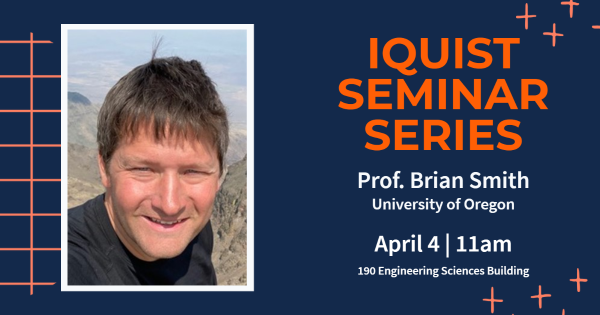
IQUIST Seminar: "Quantum-enhanced interferometric imaging: A step toward quantum-enhanced very-long-baseline interferometry for astronomy," Brian Smith, University of Oregon
- Event Type
- Seminar/Symposium
- Sponsor
- IQUIST
- Location
- 190 Engineering Sciences Building, 1101 W Springfield Ave, Urbana, IL 61801
- Date
- Apr 4, 2023 11:00 - 11:50 am
- Speaker
- Brian Smith, Professor, Department of Physics, University of Oregon
- Contact
- Hannah Stites
- hstites2@illinois.edu
- Phone
- 217-300-4072
- Views
- 162
- Originating Calendar
- IQUIST Seminar Series
Quantum-enhanced interferometric imaging: A step toward quantum-enhanced very-long-baseline interferometry for astronomy
Abstract: Increased spatial resolution of telescopes in the visible to near infrared spectral region would enable a range of astronomical studies such as imaging of small planets around nearby stars, revealing details of solar systems, kinematics of stellar surfaces, accretion disks, and structure around the event horizons of black holes – none of which can be achieved using current or planned methods. Imaging resolution is inherently limited by collection aperture size of the imaging system, encapsulated in the so-called Rayleigh criteria in which the angular resolution of an imaging system is limited to the ratio of the detected wavelength and aperture diameter. Thus, for a fixed wavelength the only way to improve the resolution is to increase the size of the imaging system. Very-long baseline interferometry (VLBI) is a technique that allows one to increase the imaging aperture of a system by coherently combining the signals from several small-diameter telescopes.
VLBI methods have been traditionally implemented in the microwave region of the electromagnetic spectrum, such as the Event Horizon Telescope that recently ‘imaged’ a black hole, where local measurement of the amplitude and phase of the electromagnetic field is straightforward and coherent analysis of the signals can be performed after measurement. For the visible and near infrared spectral domain one relies on direct interference of the fields followed by detection, such as implemented at the Center for High Angular Resolution Astronomy (CHARA) array. Here, the separation of collection apertures is limited by losses incurred when combining the light. This can be avoided by interfering the starlight with a local-oscillator laser field that acts as a phase reference. However, this approach is intrinsically limited to relatively bright objects since the laser field has inherent photon-number (so-called “shot-noise”) uncertainty that leads to reduced signal-to-noise ratio in the amplitude and phase measurement.
To overcome these challenges, we report a table-top, proof-of-principle laboratory demonstration of a technique in which light received by each telescope is interfered with an entangled state of light distributed between telescope sites and locally detected. The technique overcomes the local-oscillator shot-noise limitation by using a path entangled, single-photon state, which has no photon-number uncertainty, that acts as a shared phase reference between telescopes. In the experiment, we image double slits illuminated by a pseudo-thermal state of light derived from a pulsed laser system to act as the incoherent source to be imaged and heralded single-photon states as the quantum resource. The use of distributed entanglement between the receiving stations in this protocol allows measurements without requiring direct interference of the collected starlight and provides a route to larger baseline separations.
Bio: Brian J. Smith is Professor of Physics at the University of Oregon, where he leads the Optical Quantum Technologies (OQT) research group. Prior to this Dr Smith was Associate Professor of Experimental Quantum Physics in the Department of Physics at the University of Oxford from 2010 to 2016. He was a Senior Research Scientist at the National University of Singapore 2009-2010, where he worked on integrated quantum photonics, and quantum-enhanced sensing. He was a Royal Society Postdoctoral Fellow 2007-2009 at the University of Oxford where he worked on controlled photonic quantum state preparation and manipulation, quantum measurement characterization, and quantum-enhanced sensing. He obtained a PhD in Experimental Quantum Optics from the University of Oregon in 2007 and BA degrees in Physics and Mathematics from Gustavus Adolphus College in 2000.
Smith’s current research interests lie in the general areas of quantum optics and quantum technologies and their use in probing fundamental quantum physics and realizing quantum-enhanced applications with performance beyond that possible with classical resources. In these fields he has developed approaches for producing non-classical states of light with well-defined mode structure based upon engineered nonlinear optics, methods to coherently manipulate such quantum states, and efficient means to measure the resultant states. Recently his efforts have focused on harnessing the temporal-spectral mode structure of light to enable realization of larger quantum systems. These quantum-optical tools have enabled him to examine fundamental questions in quantum physics, such as the commutation relations for creation and annihilation operations, and experimentally address various quantum-enhanced technologies, for example quantum-enhanced sensing and quantum communications.